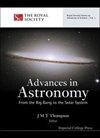Analysis and Research on the Centimeter Band Receiver Amplitude Calibration Method
IF 1.2
4区 物理与天体物理
Q3 ASTRONOMY & ASTROPHYSICS
引用次数: 1
Abstract
The receiver is a signal receiving device in a radio telescope system. As an important parameter to characterize the receiver performance, noise temperature is very practical to calibrate accurately. The traditional receiver noise temperature calibration method is the cold and ambient load method. Through the establishment of K-band ambient receiver, and its amplitude calibration test platform of the cold and ambient load method, chopper wheel method, and ambient and hot load method, comparison and analysis of the above three methods were carried out. The test and calculation results show that the test accuracy of the cold and ambient load method is about 1.3%, that of the chopper wheel method (nonlow elevation) is about 3%, and that of the ambient and hot load method is about 9%. The test accuracy of the ambient and hot load method is slightly lower than that of the above two methods. The analysis is mainly due to the uncertainty of the hot load temperature and the small temperature difference between the two loads, which leads to the deterioration of the overall accuracy. But the advantage is that the method can perform real-time calibration in the process of observation, and it is easier to implement than the traditional cold and ambient load method. The results of noise temperature measurement are compared with those of theoretical calculation, the error is basically within 10%, and it can satisfy the demand of the noise temperature test. In the future, we expect that on the basis of increasing the hot load temperature, further experiments were carried out on the thermostatic treatment of hot load and the accuracy of temperature acquisition, and finally we hope that this method can better meet the testing requirements of receiver noise temperature and radio source amplitude calibration.厘米波段接收机幅度标定方法的分析与研究
接收器是无线电望远镜系统中的信号接收设备。作为表征接收机性能的一个重要参数,噪声温度的精确校准是非常实用的。传统的接收机噪声温度标定方法是冷环境负荷法。通过建立K波段环境接收机及其冷载和环境载法、斩波轮法、环境载和热载法幅度校准测试平台,对上述三种方法进行了比较分析。试验和计算结果表明,冷负荷和环境负荷法的试验精度约为1.3%,斩波轮法(非低高程)的试验精度为3%,环境负荷和热负荷法的测试精度约为9%。环境和热负荷法的测试精度略低于上述两种方法。分析主要是由于热负荷温度的不确定性和两个负荷之间的温差较小,导致整体精度下降。但其优点是,该方法可以在观测过程中进行实时校准,并且比传统的冷负荷和环境负荷方法更容易实现。将噪声温度测量结果与理论计算结果进行了比较,误差基本在10%以内,可以满足噪声温度测试的要求。未来,我们希望在提高热负载温度的基础上,对热负载的恒温处理和温度采集的准确性进行进一步的实验,最终希望这种方法能够更好地满足接收机噪声温度和射频幅度校准的测试要求。
本文章由计算机程序翻译,如有差异,请以英文原文为准。
求助全文
约1分钟内获得全文
求助全文
来源期刊

Advances in Astronomy
ASTRONOMY & ASTROPHYSICS-
CiteScore
2.70
自引率
7.10%
发文量
10
审稿时长
22 weeks
期刊介绍:
Advances in Astronomy publishes articles in all areas of astronomy, astrophysics, and cosmology. The journal accepts both observational and theoretical investigations into celestial objects and the wider universe, as well as the reports of new methods and instrumentation for their study.
 求助内容:
求助内容: 应助结果提醒方式:
应助结果提醒方式:


